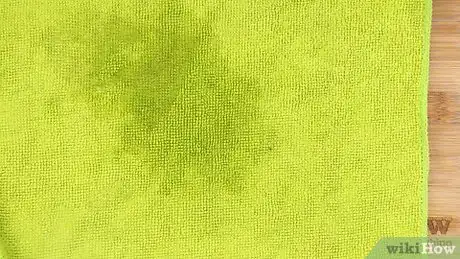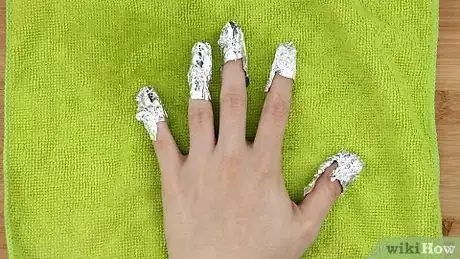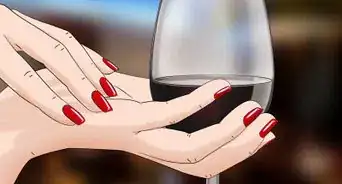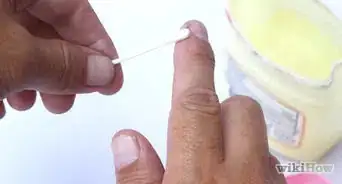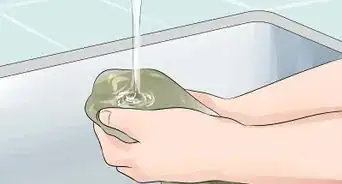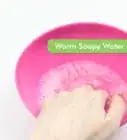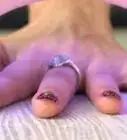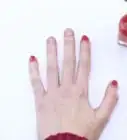This article was co-authored by Kristin Pulaski and by wikiHow staff writer, Amy Bobinger. Kristin Pulaski is a Professional Nail Artist and the Founder of Paintbucket, a self-owned and operated nail salon based in Williamsburg, Brooklyn. She has over five years of experience running Paintbucket and is licensed as a nail technician. Paintbucket offers nail art manicures, pedicures, and soft gel extensions along with customized packages for wedding and bridal parties. She holds a BA in Managerial Science from Manhattan College.
There are 7 references cited in this article, which can be found at the bottom of the page.
This article has been viewed 100,742 times.
Shellac is a brand of nail products that are a hybrid between nail polish and gel nails. The polish can be painted directly onto your nails, like polish, but they are cured by UV light, like gels. To remove them, you usually need to use a nail polish remover made from acetone, but acetone can be very drying to your cuticles and skin. If you want to avoid this, you can try soaking your nails in non-acetone nail polish remover.
Steps
Prepping Your Nails and Workspace
-
1Cover your workstation, to protect it from nail polish remover. Even non-acetone nail polish remover can damage some surfaces, so it's best to lay down newspaper, towels, a trash bag, or some other protective layer wherever you'll be working.
- If you spill enough of the polish remover to soak through the covering, stop what you're doing and clean up the spill, then lay down fresh newspaper after the area is dry.
- Glossy pages torn out of a magazine are another good option for protecting your table or countertop.
- Pick somewhere comfortable to work, like at your desk or in front of your TV. This process can take about 30 minutes.
-
2Scuff the surface of your nails lightly with a coarse nail file. If you start to see your natural nail beneath the polish, you’re filing too much. Just run the file across the surface of your nail a few times to buff away the glossy finish.[1]
- While this isn't strictly necessary, it creates more surface area on your nails for the polish remover to cover, boosting its dissolving power. Since the nail polish remover you’re using is less powerful, this step may help you achieve better results.
Advertisement -
3Coat the skin around your nails in cuticle oil. Even without the acetone, nail polish removers can dry out your cuticles and the skin around your nails. To prevent this, dip a cotton swab in some cuticle oil and rub it onto the skin around your nails, as well as the skin growing at the base of your nails, called your cuticles.[2] [3]
- If you don't have cuticle oil, use a nourishing natural oil like olive, almond, coconut, or jojoba oil.
- You can also use petroleum jelly to create a protective barrier on the skin around your nails.[4]
-
4Cut or tear 10 strips of aluminum foil to wrap around your fingers. These need to be big enough to wrap completely around your finger and the cotton ball together, and you'll need one for each finger. Aluminum foil is easy to tear, so you can do this by hand, or you can use scissors if you prefer.[5]
- Remember, it's always better to make something a little bigger than you think it should be. You can always take some off if it's too big, but you can't add more if it isn't big enough.
- The strips should be at least 2–3 sq in (13–19 cm2).
Wrapping Your Nails
-
1Soak a cotton ball in acetone-free nail polish remover. Make sure the cotton ball gets thoroughly saturated. If you want, you can tear or cut the cotton ball so it fits your nail better, but make sure it's big enough to cover the whole surface of the gel polish. You’ll need a total of 1 piece of cotton for each nail.[6]
- You can either apply the nail polish remover to the cotton ball from the bottle, or you can pour it into a small bowl and dip the cotton ball into the bowl.
- You can also use acetone-free nail polish remover pads, if you like. Fold them in half or cut them to size to minimize how much of the nail polish remover comes into contact with your skin.
- It's best to work on one nail at a time, so only soak 1 cotton ball for now.
-
2Place the soaked cotton ball on one of your fingernails. Cover your nail completely with the cotton ball. You might need to push down a little to make sure the cotton ball is pressed firmly against your nail.[7]
- You can start working on any nail you want, but it’s best to wrap the nails on your dominant hand first. That’s because once it’s wrapped, you’ll have to switch hands.[8]
- If you’re right-handed, for instance, it will be easier to wrap your right hand if your left hand is still uncovered. Then, you can use your foil-tipped right hand to cover the nails on your left hand.
-
3Wrap the aluminum foil around the cotton ball and your fingertip. Place the flat side of the foil against the cotton ball, then fold the aluminum foil around the sides of your finger and down over the top. Press and pinch the aluminum foil onto itself to seal it.[9]
- Make sure you have a secure fit, since the foil needs to hold the cotton ball in place.
-
4Repeat this process for each nail. As you’re wrapping your nails, the process will get a little more complicated, since you’ll have to try not to disturb the foil you’ve already wrapped. Just go slowly and pay attention to what you’re doing, and don’t worry too much about getting the foil just perfect.[10]
- Keep going until you've wrapped all 10 of your fingernails in the cotton balls and aluminum foil.
-
5Leave the foil in place for about 10 or 15 minutes. This will give the acetone-free nail polish remover time to soak into the nail. After the time’s up, pull away the foil on the first nail you wrapped and check the shellac. When it’s ready, it should look like it's pulling away from the nail, and it may appear softened or gummy.[11]
- If the polish isn’t pulling away from the nail, wrap your fingers and wait another 5 minutes before you check again.
Scraping Away the Polish
-
1Remove the foil from the first finger when the polish is ready. Once the nail polish starts to peel up at the edges, you can remove the foil. Again, it’s best to work with one nail at a time, so there’s no need to remove all of the foil.[12]
- If the nail polish remover starts to bother your skin, you can take the foil off of your nails. However, the shellac may become gummy or tacky as it dries, making it harder to get off. If that happens, you might need to soak your nails again.
- You might need to re-wrap your nails if all of the polish doesn’t come off, so don’t throw the foil away.
-
2Use the cotton ball to wipe away as much of the polish as you can. Push down hard on the cotton ball, wiping from the base of your nail up to the tip. If you need to, you can flip the cotton ball over and repeat the motion.[13]
- Don’t worry if all of the polish doesn’t come off; just 1-2 swipes will be fine.
-
3Scrape the remaining polish away with a wooden orange stick. An orange stick, also known as a cuticle pusher, is a small wooden stick with an angled tip. Although it’s usually used for pushing back the skin around your nails, you can also use it to remove your shellac. Work the pointed tip of the stick under the polish, then lift stick to peel the polish away from the nail.[14]
- Wooden beauty tools can act as a breeding ground for bacteria. Orange sticks are inexpensive, so buy a pack of them and discard them after each use. Never share orange sticks, which increases the risk of infection.
- You can find these tools anywhere that sells beauty or nails supplies.
-
4Re-soak your nail if there's any polish that seems too hard. Don’t scrape too hard if the polish doesn’t come away easily, or you could damage your nail bed. Instead, replace the cotton ball on your nail (using a new one if necessary), re-wrap your nail in foil, and wait another 5 minutes or so.[15]
- Acetone-free nail polish remover isn't as powerful as a version with acetone, so you'll sometimes have to soak your nails longer if the polish is especially stubborn.
-
5Repeat the same process for each of your nails. Once you’ve finished taking the polish off of one nail, you’ll have a better idea of what to expect as you continue. Unwrap the foil from each nail one-by-one, then wipe away the polish with a cotton ball and scrape away the residue with the orange stick.[16]
- When you're finished, move on to the next nail until you've removed all of the polish.
-
6Apply moisturizer to your nails when you’re finished. Non-acetone nail polish can be drying to your skin, and the process of scraping your nails can leave them feeling rough. Smooth a thin coat of moisturizer, like cuticle oil or hand cream, over the surface of your nails.[17] [18]
- You can also moisturize the skin around your nails, if you want.
Community Q&A
Did you know you can get answers researched by wikiHow Staff?
Unlock staff-researched answers by supporting wikiHow
-
QuestionHow do you remove shellac nail polish with vinegar?
 wikiHow Staff EditorThis answer was written by one of our trained team of researchers who validated it for accuracy and comprehensiveness.
wikiHow Staff EditorThis answer was written by one of our trained team of researchers who validated it for accuracy and comprehensiveness.
Staff Answer wikiHow Staff EditorStaff AnswerVinegar won’t do much to shellac nail polish. If anything, it might soften your nail a bit, which can make it easier to flex the nail and pick the polish off. Unfortunately, it can also irritate your skin, especially if you mix it with lemon juice. If you don’t have nail polish remover, soaking your nails in rubbing alcohol or hand sanitizer is a better bet.
wikiHow Staff EditorStaff AnswerVinegar won’t do much to shellac nail polish. If anything, it might soften your nail a bit, which can make it easier to flex the nail and pick the polish off. Unfortunately, it can also irritate your skin, especially if you mix it with lemon juice. If you don’t have nail polish remover, soaking your nails in rubbing alcohol or hand sanitizer is a better bet. -
QuestionDoes toothpaste work as a nail polish remover?
 wikiHow Staff EditorThis answer was written by one of our trained team of researchers who validated it for accuracy and comprehensiveness.
wikiHow Staff EditorThis answer was written by one of our trained team of researchers who validated it for accuracy and comprehensiveness.
Staff Answer wikiHow Staff EditorStaff Answer
wikiHow Staff EditorStaff Answer -
QuestionCan you peel off shellac nail polish?
 wikiHow Staff EditorThis answer was written by one of our trained team of researchers who validated it for accuracy and comprehensiveness.
wikiHow Staff EditorThis answer was written by one of our trained team of researchers who validated it for accuracy and comprehensiveness.
Staff Answer wikiHow Staff EditorStaff Answer
wikiHow Staff EditorStaff Answer
Warnings
- While some people may recommend scraping, filing, peeling, or buffing away the polish, this can tear off layers of your nail bed, leaving serious damage.⧼thumbs_response⧽
Things You'll Need
Prepping Your Nails and Workspace
- Newspaper, towels, trash bag, etc (for covering your work station)
- Coarse nail file (optional)
- Cuticle oil
- 10 2–3 sq in (13–19 cm2) strips of aluminum foil
- 10 cotton balls
Wrapping Your Nails
- Acetone-free nail polish remover
- Small bowl (optional)
- Clock or timer
Scraping away the Polish
- Orange stick
- Moisturizer
References
- ↑ https://www.more.com/beauty/nails/nail-polish/how-remove-gel-nail-polish-home-without-ruining-your-nails
- ↑ Kristin Pulaski. Salon Owner & Nail Specialist. Expert Interview. 19 May 2020.
- ↑ Mia Rubie. Nail Artist. Expert Interview. 23 April 2020.
- ↑ https://www.instyle.com/news/3-ways-remove-your-gel-manicure-without-going-salon
- ↑ https://www.allure.com/story/how-to-remove-gel-manicure-without-ruining-nails
- ↑ https://www.allure.com/story/how-to-remove-gel-manicure-without-ruining-nails
- ↑ Mia Rubie. Nail Artist. Expert Interview. 23 April 2020.
- ↑ https://www.realsimple.com/beauty-fashion/skincare/hands-feet/diy-manicure-tips
- ↑ https://www.businessinsider.com/remove-a-gel-manicure-at-home-2015-12
- ↑ https://www.allure.com/story/how-to-remove-gel-manicure-without-ruining-nails
- ↑ https://www.businessinsider.com/remove-a-gel-manicure-at-home-2015-12
- ↑ https://www.allure.com/story/how-to-remove-gel-manicure-without-ruining-nails
- ↑ Mia Rubie. Nail Artist. Expert Interview. 23 April 2020.
- ↑ https://www.allure.com/story/how-to-remove-gel-manicure-without-ruining-nails
- ↑ https://www.allure.com/story/how-to-remove-gel-manicure-without-ruining-nails
- ↑ https://www.allure.com/story/how-to-remove-gel-manicure-without-ruining-nails
- ↑ Kristin Pulaski. Salon Owner & Nail Specialist. Expert Interview. 19 May 2020.
- ↑ Mia Rubie. Nail Artist. Expert Interview. 23 April 2020.
About This Article
To remove shellac without acetone, soak a cotton ball in non-acetone nail polish remover, then press it onto the surface of each nail. Make sure to cover the entire painted surface. Wrap a piece of foil around each nail to hold the cotton ball in place, and leave it there for 10-15 minutes. When the time is up, unwrap your nail and check to make sure the shellac looks loose. If it does, wipe off most of the polish with the cotton ball, then scrape the rest away with an orange stick. To learn how cuticle oil can protect your skin from drying out during this process, read on!
